
A report prepared for Irish Steel by Jim Power Economics, July 2024 INTRODUCTION Irish Steel was founded in 2014 after the introduction of the Construction and Product Regulations (CPR). The founders of Irish Steel recognised at that stage that there was a major information deficit for steel fabricators around the new mandatory standards and wanted […]

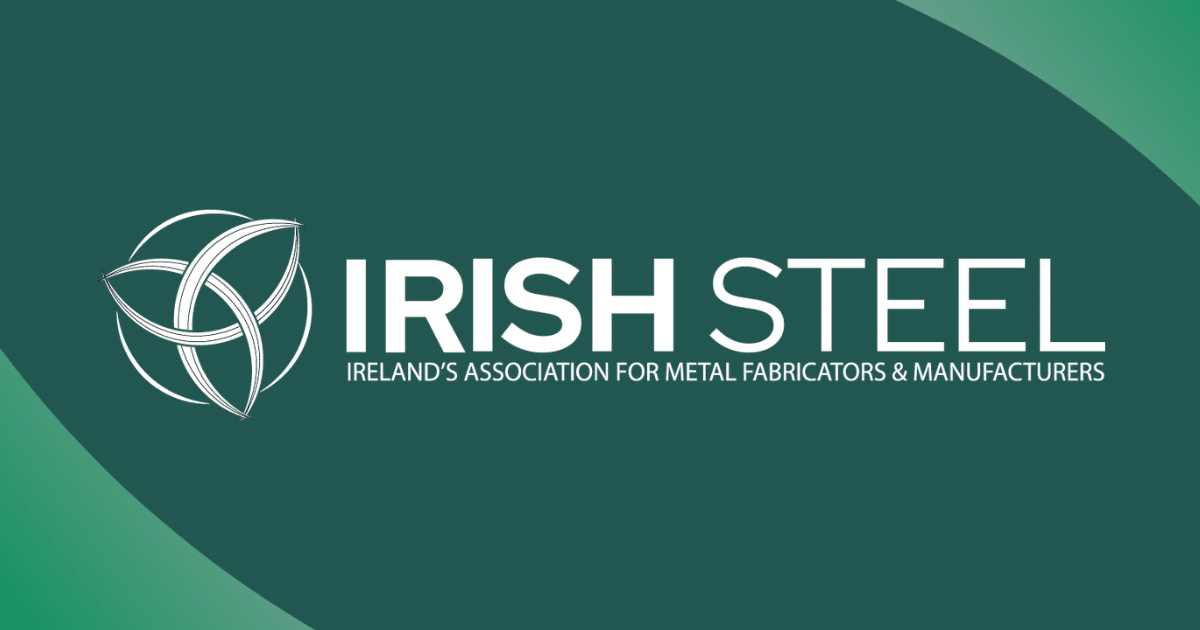
A report prepared for Irish Steel by Jim Power Economics, July 2024
Irish Steel was founded in 2014 after the introduction of the Construction and Product Regulations (CPR). The founders of Irish Steel recognised at that stage that there was a major information deficit for steel fabricators around the new mandatory standards and wanted to create a Network to share information.
Irish Steel sees itself as the knowledge, expertise and connection hub for Ireland’s metal fabrication and manufacturing community.
Vision
By making outstanding programmes and services available, our membership will participate and collectively benefit from an increase in excellence within the Irish metal fabrication and manufacturing industry’s community.
Mission
We are dedicated to helping our members build more resilient and successful businesses by bringing industry stakeholders together to share knowledge and use their collective experiences for good during the time that we set the seeds for collaborative mindsets to become the daily norm amongst all members of our industry and community.
Key issues
and services that the Irish steel sector provides and produces looks positive. The economy is doing reasonably well; interest rates are starting to come down and are projected to fall by between 1.5 and 2 per cent over the next 18 months; and the demand for product and services from key sectors such as construction, public infrastructure, alternative energy and agriculture should hold up over the coming year.
The operating environment for the sector is very challenging. Labour shortages are acute; the cost of labour is rising strongly; recent labour market changes are adding to business costs; and elevated non-labour costs are creating significant problems for the steel sector.
The following issues are highlighted in this report.
General Employment Permits
• The Apprenticeship Scheme
• Increased Cost of Labour
• Elevated Business Input Costs
• Access and Cost of Finance
• Changes to Retirement Relief
Section 1 considers some key trends in the global steel industry. Someof these factors are very relevant to the Irish steel and fabrication sector, and some less so. However, it is important to understand the domesticIrish market in the context of global trends.
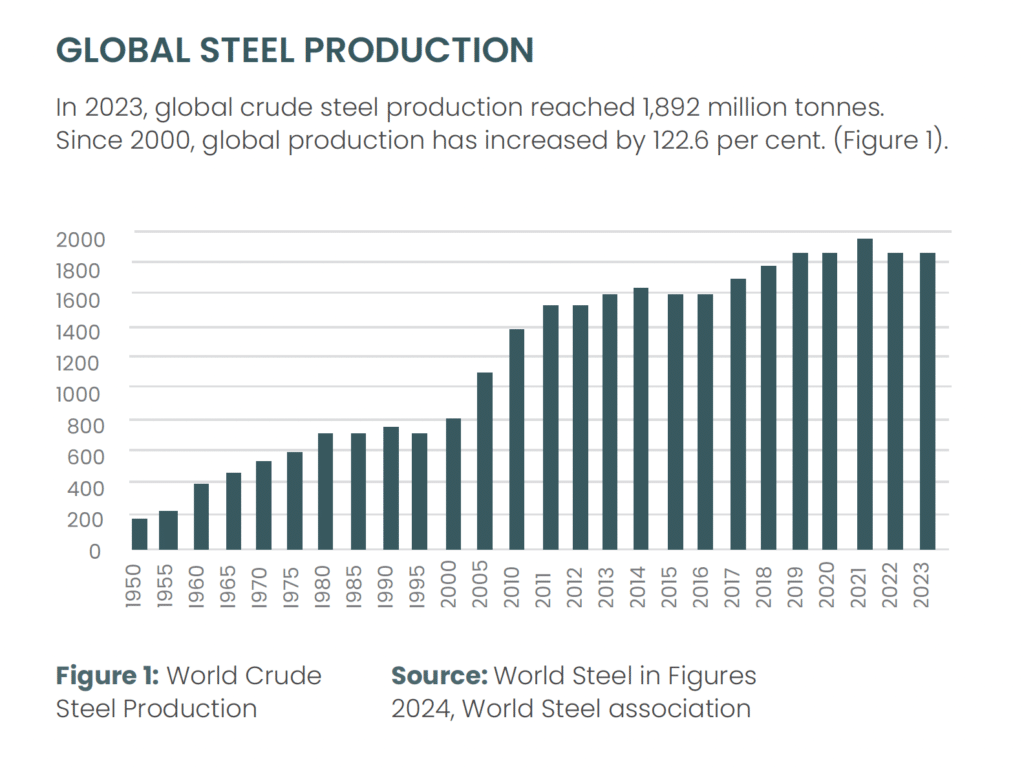
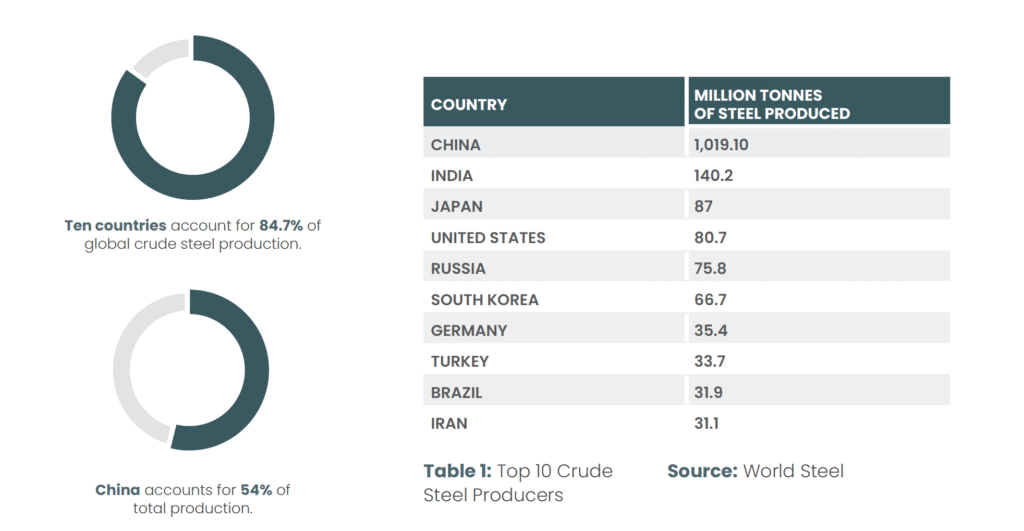
FACTORS INFLUENCING GLOBAL STEEL PRODUCTION
The overall health of the global economy is the fundamental driver of the demand for steel. When global economic activity is strong, there is increased construction, infrastructure development, consumer demand, and manufacturing activities. All of these activities, and more, drive demand for steel.
In assessing the current global steel market situation, it is important to understand the key drivers of the steel market. These include:
Global economic growth
Steel is a key component of many industries, including manufacturing, infrastructure development, and construction. Quite simply, stronger economic growth typically results in higher demand for steel. In recent decades, steel has been in high demand due to the robust economic expansion in emerging economies, especially in nations like China and India.
Urbanisation and industrialisation
Urbanisation and the growth of cities is an important global mega-trend. Demand for steel is being heavily influenced by urbanisation and industrialisation occurring in developing nations. Steel is used in the construction and manufacturing of machinery, equipment, and residential and commercial buildings. As cities grow, the demand for steel grows.
The automotive industry
The automotive industry is a key driver of demand for steel. Steel is used for car bodywork, chassis, and other components. The demand for steel typically rises in response to increases in auto sales and manufacturing.
Infrastructure development
A significant amount of steel is needed for infrastructure projects such as utilities, roads, bridges, railroads, and airports. Government infrastructure programmes are particularly important drivers of demand.
Construction Sector
A sizeable amount of steel consumption is accounted for by construction activities, which include residential, commercial, and industrial construction.
Energy Sector
The development of energy infrastructure is an important driver of global steel markets at the moment. This includes activities such as pipelines, offshore platforms, power generation facilities and alternative energy production
Trade Agreements & Tariffs
By influencing the price of steel imports and exports, trade agreements and tariffs can have a significant impact on the world steel market. Trade disputes between the main producers of steel can alter market dynamics and cause supply chains to break. Recently, the European Commission notified the WTO of its intention to extend the EU Safeguard measure on steel imports until mid-2026. This extension aims to protect steel producers by managing the volume of steel imports to the EU, to ensure a stable market environment. The European Commission has also extended its anti-dumping measures on imports of certain stainless steel seamless pipes and tubes from China. The anti-dumping duties range from 48.3 per cent to 71.9 per cent. The rationale for this measure is to counteract the dumping of these products at unfairly low prices, which has the effect of harming EU producers.
Prices of raw materials
Steel production costs and, by extension, steel prices can be greatly influenced by the price and availability of raw materials such as coal, iron ore, and scrap metal. The financial performance of steel companies can be significantly impacted by changes in the price of raw materials.
Geopolitical Risks
In important steel-producing regions, political unrest, trade disputes, and geopolitical conflicts can upset supply chains and have an effect on market dynamics. The unpredictability of geopolitical developments might lead to fluctuations in steel pricing and investment choices.
Environmental Regulations
The steel industry accounts for up to 9 per cent of global CO2 emissions. There is now a strong focus on the environment performance of the sector. The sector will face challenges due to stricter environmental laws designed to lower carbon emissions and promote sustainability. The sector will have to adopt new technologies to meet emissions regulations. This challenge is common to all economic sectors.
Price Trends
Global steel prices spiked dramatically in the second half of 2020 as global supply chain problems impacted on supply. Between July 2020 and November 2021, the producer price of iron and steel increased by 126 per cent. Prices have subsequently eased back and between November 2021 and June 2024 prices declined by 33 per cent. However, prices in June 2024 were still 51 per cent higher than in July 2020. (Figure 2).
At the beginning of July 2024 steel rebar futures prices fell to the lowest level since April 2020. The key factor now impacting on prices is the slowdown in the Chinese economy. Of particular relevance is the sharp contraction in the Chinese property and construction sector. For example, home sales from China’s 100 largest real estate companies fell by 34 per cent annually in May, following a 45 per cent plunge in April. As one of the world’s largest consumers of steel, the slowdown in investment in property is having a significant impact on the global steel market. While there are official efforts being made to revive the Chinese economy and property sector, markets are sceptical about the chances of success. Chinese property development is a major source of global steel demand.
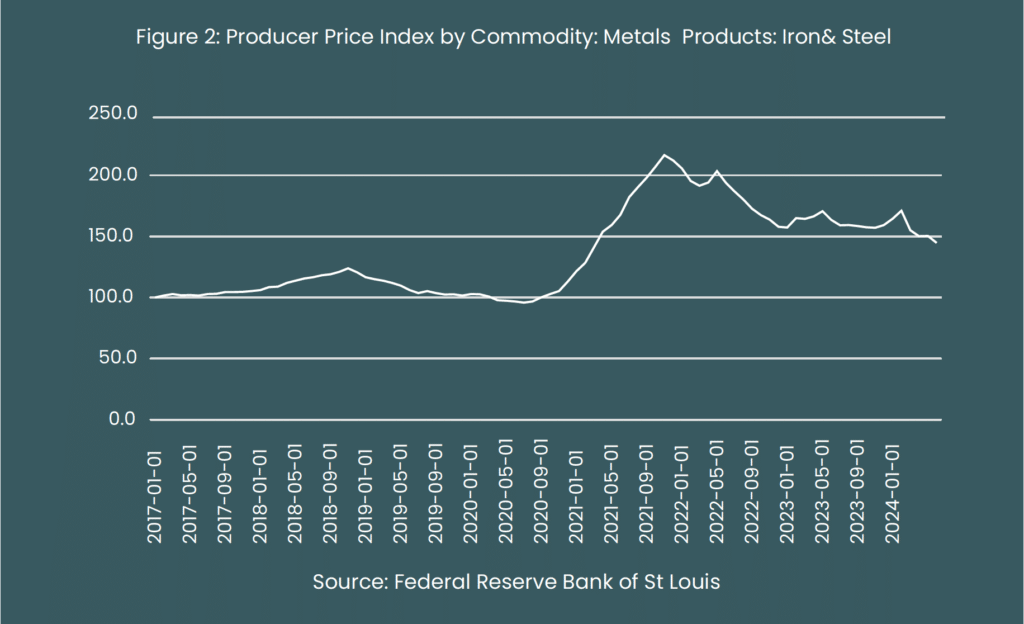
In any consideration of the domestic environment for the Irish steel and fabrication sector, the global environment in which the Irish economy operates is important. In that context, the story is now reasonably positive.
The past couple of years have been dominated by high inflation, significantly higher interest rates, and a high degree of nervousness and negativity about prospects for the global economy.
Interest rates peaked towards the end of summer 2023 in the US, UK, and Euro Zone; inflation came down more quickly than expected as 2023 progressed, not least due to the sharp decline in global energy and food prices; and the global economy did not go into recession, and in fact the US economy surprised on the upside.
As we move into the second half of 2024, there is greater optimism about global economic prospects; inflationary pressures continue to gradually ease; and interest rates have started to come down in some jurisdictions, most notably in the Euro Zone. The ECB cut official interest rates by 0.25 per cent at the June meeting.
The Euro Zone economy experienced a mild technical recession in 2023 but returned to growth in the first quarter of this year. In the first quarter, GDP in Germany expanded by 0.2 per cent; it expanded by 0.2 per cent in France, by 0.7 per cent in Spain and by 0.3 per cent for the Euro Area as a whole. While these growth rates do suggest economic recovery, the reality is that in the first quarter of 2024, Euro Zone GDP was just 0.4 per cent higher than the first quarter of 2023. There is still some distance to go before the Euro Zone economy approaches a level of growth close to potential, but things are getting better. The latest forecast from the IMF (July 2024) was mildly upbeat. The IMF believes that global growth will be a bit stronger over the coming year, helped by lower energy prices, interest rates and inflation. The risks to global growth are reasonably clear. Persistent service sector inflation is delaying the decline in inflation; price pressures emanating from renewed trade or geopolitical tensions; weak productivity; and interest rates that may remain ‘higher for longer.’
Global geo-politics represent the most significant threat to economic well-being. It is a very big year for elections around the world, with the European Parliamentary elections in June; the UK general election on July 4th; a French parliamentary election at the end of June; and the US election in November arguably the most important. In addition, there are a lot of wars going on around the world, with Gaza and Ukraine the highest profile, but many other countries are experiencing wars.
In summary, the global geo-political backdrop is very risky. The risks include a further energy price shock; a more dangerous deterioration in the relationship between the US and China; and further threats to free trade and globalisation. Donald Trump is promising 60 per cent tariffs on imports from China, and 10 per cent tariffs on all other US imports. This would damage global trade and impact on Ireland’s export performance
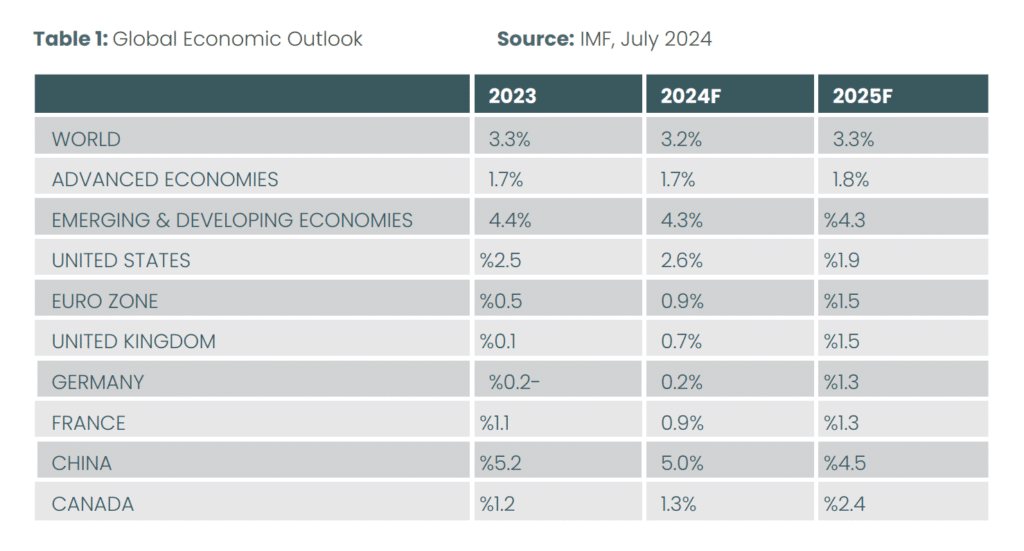
The United Kingdom economy expanded by a meagre 0.1 per cent in 2023, followed a robust post-Covid growth rate of 4.3 per cent in 2022. This was the weakest annual growth since the 2009 financial crisis, excluding the pandemic-hit year of 2020. In the period from 2012 to 2023 real GDP growth averaged just 1.58 per cent, which represents a poor long-term growth performance. The UK economy went into technical recession in the second half of 2023, but emerged from recession in the first quarter of 2024, with GDP expanding by 0.7 per cent.
The new Labour government is intent on trying to revive the UK’s growth performance. In her first official speech, the Chancellor of the Exchequer highlighted increased housing supply as the key priority and pledged that the new government would have a much more interventionist approach. The Government has set a mandatory housing target of 1.5 million over five years. A new task force to accelerate stalled housing developments is being set up; 300 extra planning officers will be employed by local authorities; there will be a review of rejected planning applications; the planning system will b e reformed; brownfield and grey belt land will be prioritised for development; and there will be policy interventions for the development of critical infrastructure. The ban on onshore wind farm development will also be scrapped.
The new government has laid out ambitious plans, which if delivered would give a significant boost to steel market activity.
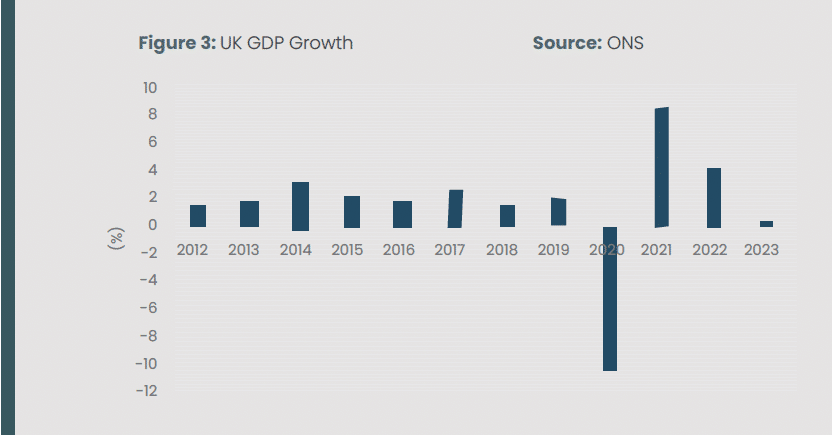
The UK economy suffers from low productivity and weak investment and has been damaged by Brexit. The economy is forecast to grow by 0.5 per cent in 2024 and 1.5 per cent in 2025. The prospects for the economy are modest at best, and the problem is that the fiscal situation is not conducive to significant government investment. The Chancellor of the Exchequer has promised that the Treasury will be very pro-growth. Britain needs to increase capital investment and seriously accelerate house building if growth and productivity are to be boosted.
The Northern Ireland economy continues to face significant challenges. GDP per capita at £29,674 (2022) is 19.5 per cent below the UK average. However, the economy is now performing reasonably well. The economy has grown by 38 per cent in real terms since the Belfast Agreement, compared to 41 per cent in the UK, 38 per cent in Scotland, and 40 per cent in Wales.
Productivity growth is a problem for the overall UK economy, but Northern Ireland’s productivity gap has been consistently below the UK average over the past two decades. The potential growth in the economy is positive, as it is likely to benefit from inward investment and significant investment in public infrastructure.
In understanding the Irish economy, very careful interpretation of economic data is necessary. Gross Domestic Product (GDP) is the normal metric used to measure economic activity, but in the case of Ireland, this measure is distorted by some of the activities of multi-national companies which are captured in GDP, but which do not reflect what is happening on the ground in the real economy. The CSO estimates that GDP expanded by 0.7 per cent in the first quarter of the year, suggesting that the technical GDP recession ended. GDP had contracted in all four quarters of 2023.
Modified Final Domestic Demand (MDD) is a more meaningful measure of domestic demand in the economy. It expanded by a reasonably strong 1 per cent during the first quarter on the back of solid growth in consumer expenditure on goods and services. All in all, the economy performed reasonably well during the first quarter.
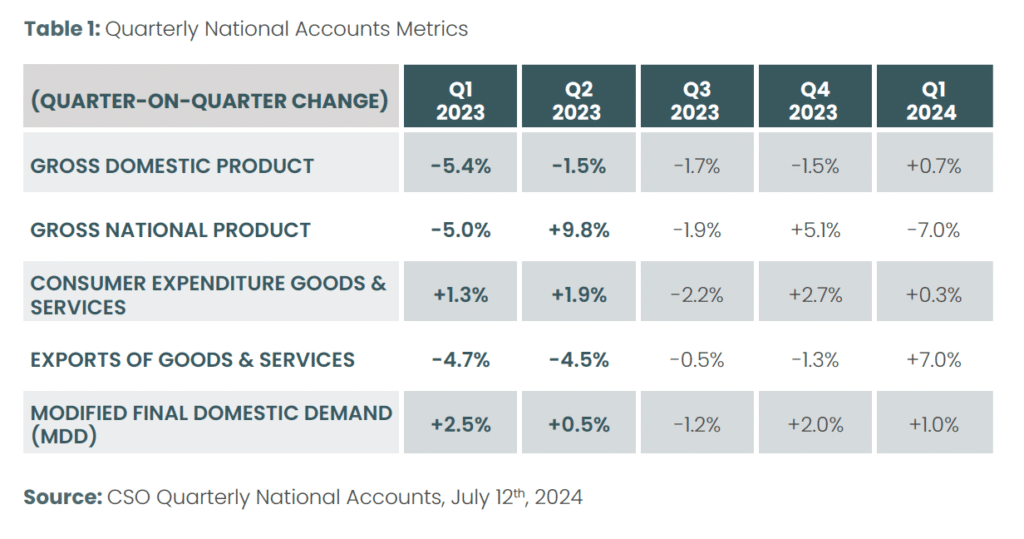
This level of growth has carried through into the second quarter.
They key metrics in the economy at the moment can be summarised as follows:
Global economic growth
Steel is a key component of many industries, including manufacturing, infrastructure development, and construction. Quite simply, stronger economic growth typically results in higher demand for steel. In recent decades, steel has been in high demand due to the robust economic expansion in emerging economies, especially in nations like China and India.
Tax revenues
An Exchequer surplus of €3.1 billion was recorded in the first six months of this year. This compares to a surplus of €0.3 billion in the first half of 2023. Tax receipts of €44.7 billion were collected, which is €3.8 billion or 9.3 per cent ahead of 2023. This tax revenue buoyancy was driven primarily by strong growth in income tax and corporation tax, and to a lesser extent VAT.
Exports
2023 was a more challenging year for the Irish export sector than was seen for some time. Merchandise exports declined by 5.5 per cent. Exports of food declined by 1.3 per cent; exports of chemicals & related products declined by 4.9 per cent, with medical & pharmaceutical products down by 2.9 per cent and organic chemicals down by 19.6 per cent; and electrical machinery was down by 38.8 per cent. These declines reflected a slower global economy, but more than that, a significant post-covid adjustment in the pharmaceutical sector.
The export performance so far in 2024 has seen a marked improvement. In the first five months of the year, overall exports were up by 9.9 per cent, with food down by 0.1 per cent; chemicals and related products were up by 10 per cent; and exports of machinery and transport equipment were up by 20.9 per cent.
Exports to Great Britain were down by 0.4 per cent, but imports declined by 28.7 per cent. Great Britain accounted for just 7.9 per cent of Irish merchandise exports in the first five months. The EU-27 accounted for 39.5 per cent and the United States accounted for 30.9 per cent. Brexit is clearly complicating the trade relationship with Great Britain.
Consumer dynamics
Consumer confidence slipped modestly in May, which was the fourth consecutive monthly decline in consumer sentiment. There was a modest improvement in June on the back of the ECB rate cut. Ongoing pressures from the elevated cost-of-living are an ongoing pressure on consumers. In terms of spending, the degree of caution apparent in the consumer confidence reading is impacting. In May, the volume of retail sales was 1 per cent lower than May 2023. In the first five months of 2024, the volume of retail sales was 1.5 per cent ahead of the same period in 2023. When car sales are excluded, the volume of retail sales was 0.7 per cent higher than the first five months of 2023. This level of spending is soft and it is clear that cost of living increases are impacting on consumer behaviour.
The economic outlook
The domestic economy is still showing reasonably strong momentum. The labour market is strong; exports are recovering; and the public finances are healthy. Consumer spending is under some pressure due to cost-of-living pressures. The SME sector is challenged.
The SME sector is a vital component of the Irish economy and is particularly important for regional employment and general economic activity. In 2021, there were 349,338 SMEs operating in the Irish economy, accounting for 99.8 per cent of business enterprises in Ireland. These SMEs employed 1.3 million employees, which is equivalent to 69.2 per cent of business employment in the economy.
The SME sector, particularly those operating in hospitality and retail, are finding the business environment challenging. Several measures have been or are about to be introduced that are adding significantly to the cost of doing business. These measures include the increase in the national minimum wage of 12.4 per cent on January 1st; the progression towards a living wage of €15 per hour by 2026; the increase in the VAT rate for the hospitality sector from 9 per cent to 13.5 per cent on 1st September 2023; statutory sick pay changes; parental leave changes; the extra bank holiday; higher PRSI; and auto-enrolment for pensions. The measures will combine to increase costs significantly for SME businesses across diverse sectors. These businesses were already under significant pressure due to higher energy costs, higher food prices, labour shortages, and other input costs, and a more challenged consumer. The Government has responded with a package of measures aimed at easing pressures on the SME sector.
Notwithstanding these challenges, the overall economic outlook is positive for the next 12 months.
Inflation is likely to average around 2 per cent this year, while wages are likely to increase by around 4 per cent; interest rates have started to come down and will likely fall further over the next 18 months; fiscal policy is very expansionary as manifested in a very significant Budget 2024 package, and another similar package in Budget 2025; and the global outlook is reasonably positive
Ireland needs to deliver significant capital investment across the economy over the coming years to cope with a rapidly growing population; a significant shortage of housing; the development of alternative energy; and public infrastructure such as schools, hospitals, and facilities for older people. Ireland has a growing population and an ageing population, and significant capital investment will be required to cater for these trends, and also to address Ireland’s climate change obligations.
The construction sector
The lack of supply of housing for owner-occupier and rental purposes is now the biggest economic and social challenge facing Ireland. Against a background of sharply rising mortgage rates and affordability issues, national average residential property prices eased in the second half of 2022 and for the first half of 2023. However, in the second half of 2023, price pressures started to build again reflecting strong inherent demand and limited supply. This has continued into 2024.
• National average residential property prices increased by 7.9 per cent in the year to April 2024. The annual growth rate is down from a peak growth rate of 15.1 per cent in March 2022.
• Average residential property prices Outside of Dublin increased by 7.6 per cent in the year to April. The annual growth rate is down from a peak rate of 17.1 per cent in March 2022.
• Average residential property prices in Dublin increased by 8.3 per cent in the year to April. The annual growth rate is down from a peak rate of 13.2 per cent in February 2022.
• The national residential property price index in April 2024 was 9.6 per cent above its highest level at the peak of the property boom in April 2007. Dublin prices are 1.8 per cent lower than their February 2007 peak, and prices Outside of Dublin are 10.2 per cent above their May 2007 peak.
• CSO data show that private rents increased by 4.9 per cent in the year to June 2024. Between June 2012 and June 2024, average private rents increased by 114.9 per cent.
A recent report from the Housing Commission has estimated that, as of the 2022 Census, there was a housing deficit of between 212,500 and 256,000 homes in Ireland. The basis for this deficit is obvious from the low level of housing construction in the decade after 2008; a largely static household size over the same period; low levels of availability of rental and owner-occupied housing; and high rates of homelessness.
In 2023, there were 32,626 residential units completed. However, between 2011 and 2023 annual completions averaged 15,043 and hit a low of just 4,575 in 2013. This is despite rapid growth in population. It will take some years to satisfy actual and latent demand, but everything possible needs to be done to increase supply as quickly as possible.
Ireland needs to deliver an average of at least 50,000 residential units per annum over the next decade. This will require changes to planning; a proper financing mechanism for development, including significant overseas investment; higher densities; increased capacity; and proper investment in public utilities, particularly water and electricity.
Outside of residential development, Ireland has a broader investment strategy. The NDP is a strategic component of Project Ireland 2040, which was introduced in 2018, and it outlines a decade-long public capital investment framework. With a total public investment of €165 billion, this plan aims to elevate public investment to 5 per cent of Gross National Income (GNI) surpassing the EU average. This incorporates€91 billion of Exchequer investment and €25 billion of non-Exchequer investment, which includes investments from the commercial semi-state sector. The funding model for the NDP ensures a diversified investment strategy that leverages both public and semi-public resources for nationwide development projects.
This plan continues to be rolled out and Government is now committing significant resources to capital investment, and the Exchequer surpluses that are being deliveredare facilitating this investment.
Steel input costs to the construction industry increased significantly after the Russian invasion of Ukraine. Between Jan 2022 and February 2023, the price of structural steel increased by 61.5 per cent, and the price of structural steel fabricated metal increased by 73.1 per cent. Prices have subsequently eased somewhat but remain at elevated levels.
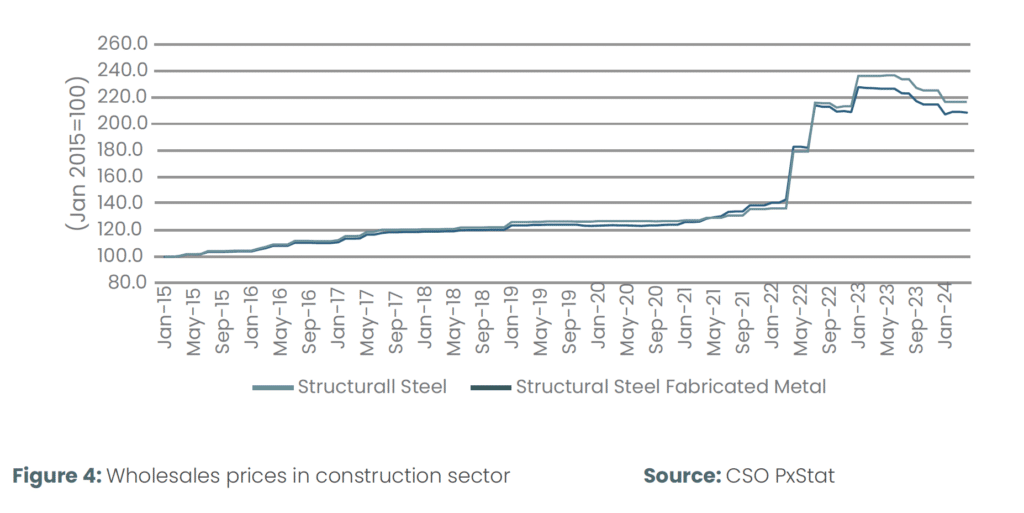
Climate change agenda
Ireland has an international commitment to achieve a 51 per cent reduction in Greenhouse Gas (GHG) emissions by 2030, compared to 2018 levels, and to achieve carbon neutrality by 2050. To achieve these targets, a multi-faceted approach will be required. This will involve the electrification of the transport fleet; the development of alternative energy sources, including solar, offshore and onshore wind; and biogases; the retrofitting of homes, including solar panels; and charging infrastructure. This agenda will require significant public and private investment and will give a significant boost to economic activity, and the Irish steel industry.
The multi-national sector
Employment in IDA supported multi-nationals declined marginally by 0.3 per cent to 300,583 in 2023. ICT employment declined by 2.9 per cent; modern manufacturing increased by 1.8 per cent; traditional manufacturing increased by 0.2 per cent; and employment in business, financial and other services increased by 0.8 per cent. The multi-national sector accounts for 11.3 per cent of national employment, but clearly the role of the IDA is becoming more challenging, as evidenced by a slowdown in activity in the first half of this year. This reflects global growth challenges; post-covid adjustment in the chemical and pharmaceutical sector globally; global corporation tax developments; increased competition for mobile investment; and domestic cost and competitiveness challenges, particularly the cost and availability of housing for rental and ownership purposes.
Despite the challenges, Ireland is still performing strongly with FDI, and continued investment will be a feature of the sector for the period ahead.

Agriculture
The farming sector continues to be characterised by significant volatility, due to factors such as volatile input and output prices and more extreme weather conditions. The operating surplus increased by 28.3 per cent in 2022 to reach a record high of €4.7 billion, but it then declined by 35.9 per cent in 2023.
Agricultural input and output prices increased sharply from 2020 to the end of 2022. Between November 2020 and December 2022, input prices increased by 56.1 per cent and output prices increased by 59 per cent. Input prices have subsequently eased back by 17.7 per cent, and output prices have eased by 15 per cent, although they have started to trend upwards in recent months. (Figure 6).
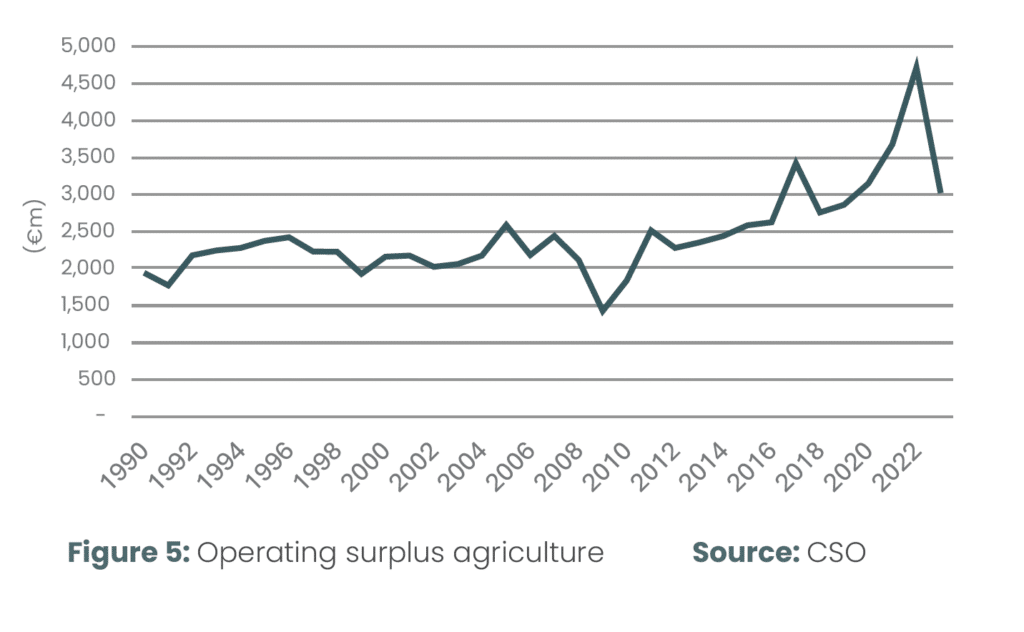
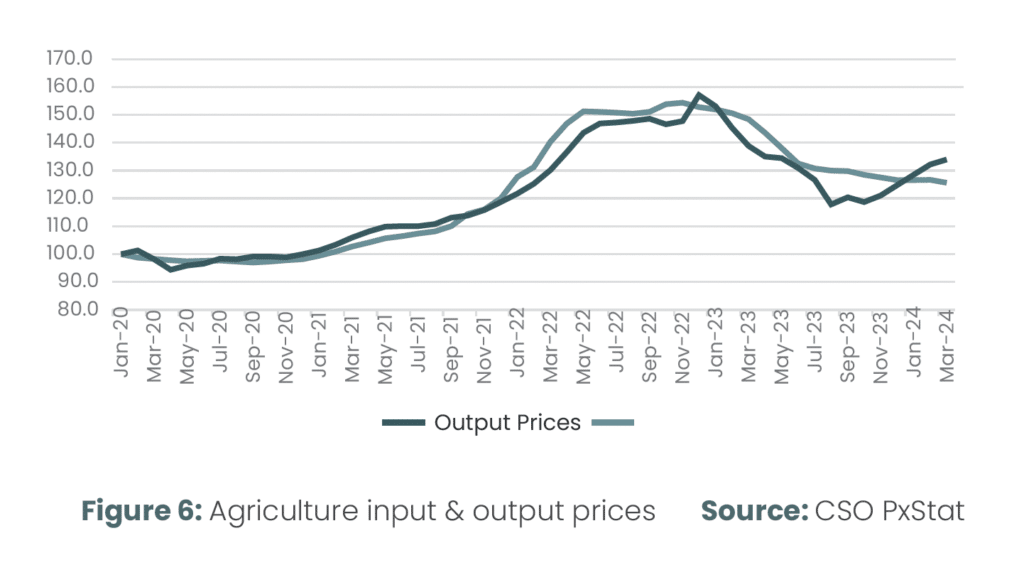
Farm incomes are becoming more volatile due to volatile input and output prices, and more extreme and unpredictable weather conditions. Farmers are also challenged by environmental obligations and pressure to cut back output. However, there is still strong investment occurring as farm level caused by the need to keep cattle indoors longer, environmental obligations, and expansion by dairy farmers in particular.
Figure 7 shows capital investment by farmers in machinery & equipment, farm buildings, and maintenance 7 repairs. All three categories have expanded strongly over the past five years. This upward trend looks set to continue, despite the challenges.
One of the issues that is challenging farm construction is the cost of cement. Wholesale cement prices in May 2024 were 42 per cent higher than May 2021. This is causing some pressure on farm construction activities.
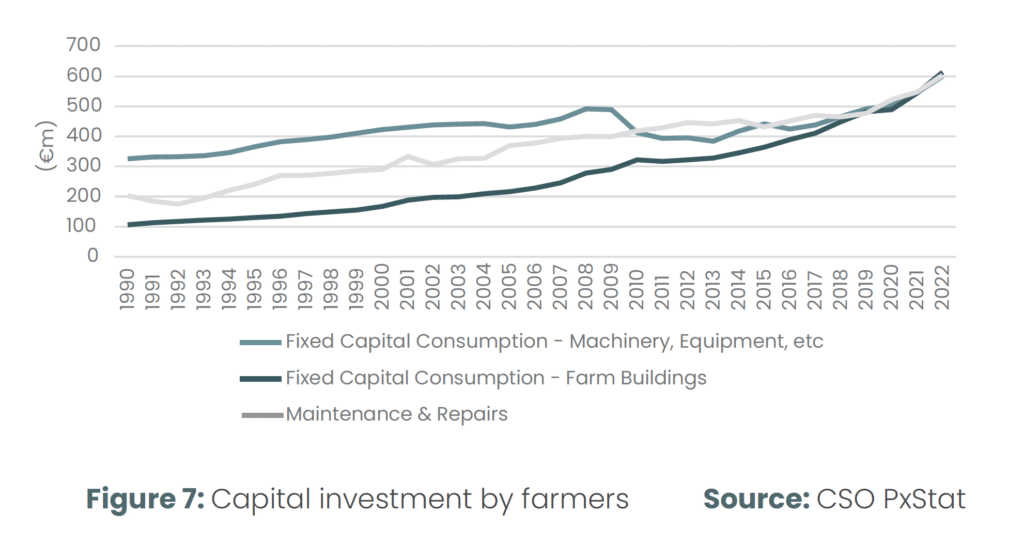
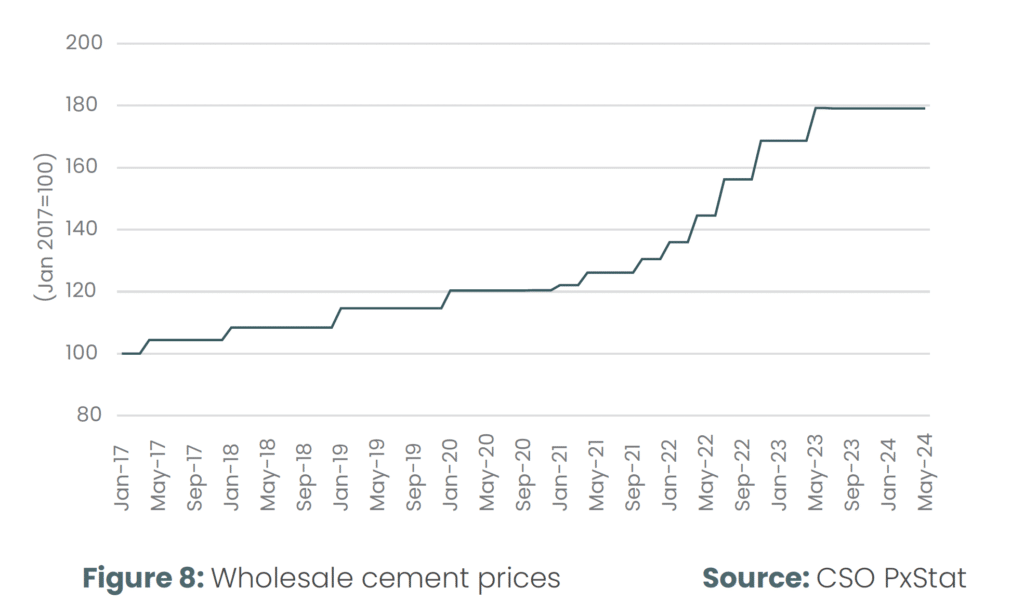
The general outlook for demand for the goods and services that the Irish steel sector provides and produces looks positive. The economy is doing reasonably well; interest rates are starting to come down and are projected to fall by between 1.5 and 2 per cent over the next 18 months; and the demand for product and services from key sectors such as construction, public infrastructure, alternative energy and agriculture should hold up over the coming year.
However, the operating environment for the sector is very challenging. Labour shortages are acute; the cost of labour is rising strongly; recent labour market changes; and elevated business costs are creating significant problems for the steel sector.
General employment permits
The labour market is very tight and is operating at full employment. This is creating considerable labour scarcity and wage costs are under intense pressure. Recruitment and retention of suitably qualified and skilled staff is a major challenge. There is an extreme skills gap for fabrication welders and experienced CNC machine operators in particular. Changes to the general employment permit system which saw an increase of 13 per cent to €34,000, with an intention to gradually increase it to €39,000 will cause serious difficulties in the steel sector.
The apprenticeship scheme
The apprenticeship scheme is not delivering the skilled labour supply that is required. There needs to be a very strong government focus on investing heavily in apprenticeship schemes across the economy, but particularly steel sector workers.
Increased cost of labour
The SME sector in general is finding the business environment challenging. Several measures have been or are about to be introduced that are adding significantly to the cost of doing business. These measures include the increase in the national minimum wage of 12.4 per cent on January 1st to €12.70 per hour; the progression towards a living wage of €15 per hour by 2026; statutory sick pay changes; parental leave changes; the extra bank holiday; higher employer PRSI rates from October 2024; and auto-enrolment for pensions. These government measures will combine to increase costs significantly for SME businesses across diverse sectors.
Elevated business input costs
The increase in the cost of labour is coming on top of significantly elevated other costs of doing business, such as insurance costs and energy costs. Figure 8 shows the recent trend in wholesale electricity costs. Prices spiked dramatically in 2021 and 2022, and while prices have subsequently eased, the wholesale price of electricity in May 2024 was still 358 per cent higher than in May 2020.
Access and cost of finance
The cost of borrowing has increased significantly since 2022. While borrowing costs look set to decline over the next couple of years, access to finance is a significant challenge for SMEs in particular. There is a lack of choice and real competition in the banking sector, and this is hitting smaller businesses in particular.
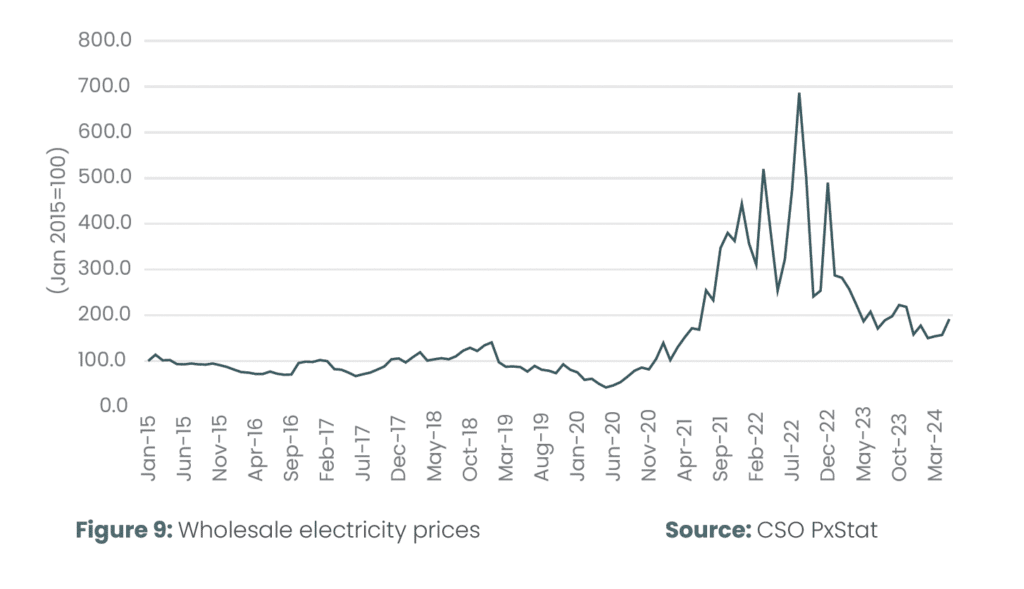
Changes to retirement relief
From January 1st, 2025, significant changes are being introduced to retirement relief that will cause significant challenges for family businesses.
For individuals aged 55 to 69 years, full relief from CGT on a transfer to a child where the market value of the qualifying assets or shares does not exceed €10 million at the time of disposal. Value in excess of €10 million will be subject to a CGT rate of 33 per cent. The ceiling drops to €3 million if the person is aged 70 or over. The proposed changes to retirement relief on the transfer of a family business to a child do not make sense in an economy where there is an urgent need to promote and grow an indigenous sustainable SME sector in the economy to diversify concentration risk caused by the heavy dependence on the foreign-owned multi-national sector.
The SME sector plays a very important role in the Irish economy and make a very significant contribution to rural and regional economic activity and employment throughout the country. Many SME are family businesses, and it is essential to ensure that family businesses continue to play an important role in the Irish economy and make a very strong contribution to the development of sustainable Irish indigenous businesses.
The retirement relief regime facilitates the growth, development, and continuity of family businesses. The impending changes to the relief will undermine the positive attributes of family businesses and damage the positive benefits that the relief has delivered.
The clear risk is that the changes will:
The bottom line is that the impending changes to retirement relief will damage the family business network in Ireland as family businesses may be faced with significant tax bills.
The key adverse effects would include:
There would be less incentive to create family businesses and build them up. Only small family businesses will qualify for full CGT retirement relief, so there will be no incentiveto grow beyond a certain size.
The changes could result in a delay in the transfer of family businesses until death, as the cost of extracting funds to cover a CGT liability would undermine the financial and operational viability of the business.
Raising the funding to pay a CGT liability could involve borrowing, selling off assets, letting staff go,and downsizing.
Lifetime transfers of family businesses would be discouraged and deferred, resulting in lower tax receipts arising from stamp duties and CAT.
Irish Steel has made a submission to Government in relation to this critical issue.
Carbon border adjustment mechanism (CBAM)
The EU Carbon Border Adjustment Mechanism (CBAM) came into effect on 1st October 2023. This has resulted in a new set of reporting requirements for importers into the EU.
As the EU raises its climate ambition and less stringent environmental and climate policies prevail in some non-EU countries, there is a strong risk of so-called ‘carbon leakage› – i.e. companies based in the EU could move carbon-intensive production abroad to take advantage of laxer standards, or EU products could be replaced by more carbon-intensive imports. Such carbon leakage can shift emissions outside of Europe and therefore seriously undermine the EU’s as well as global climate efforts.
The CBAM is intended to support the EU’s climate ambition and ensure that climate action is not undermined by production relocating to countries with less ambitious policies.
The European Parliament and the Council of the European Union signed the CBAM Regulation (EU) 2023/956 on 10th May 2023. The set of rules and requirements for the reporting of emissions under CBAM are further specified in Implementing Regulation (EU) 2023/1773 laying out reporting rules during the transitional period. The Commission has set up the transitional CBAM registry, is preparing further secondary legislation, and carrying out the planned analysis. The definitive period of CBAM will enter into force in January 2026.
The European Commission has made available detailed guidance for the application of CBAM during the transitional period. These include detailed manuals, webinars, e-learnings, and other materials. All information supporting the implementation can be accessed on the Commission’s CBAM web page.
There is a four-year transitional period from 1st October 2023, during which businesses will only have reporting obligations. From 1st January 2027, when the mechanism is expected to be fully implemented, liable companies will also bear the financial burden by being required to pay guarantees and purchase CBAM certificates.
CBAM initially will apply to a limited number of product categories and then the scope may be extended to cover other product categories including organic chemicals and polymers. It will have implications for the steel industry and will increase costs.
UK insolvencies
Steel makers are closing all four of the UK’s remaining blast furnaces, and instead are planning government-subsidised greener arc furnaces. De-carbonisation of the steel industry is a key policy in the UK. The end of traditional blast furnace steelmaking is a significant shift for the industry that will play out over the coming years.
Considerable domestic capacity is being taken out and this is causing supply chain disruption and could force greater reliance on Tariff Rate Quota (TRQ) restricted imports going forward. These quotas allow for a certain volume of steel imports, with a 25 per cent tariff applied once this limit is reached.
The UK steel industry is under significant pressure. There has been a significant increase in insolvencies in the steel sector over the past couple of years. In the metals sector, insolvencies increased by 18 per cent in 2023, with structural steel fabrication companies accounting for 29 per cent of the total. Weak demand and higher input costs are putting serious pressure on the sector. With interest rates set to come down and the new Government set to ramp up investment in construction and alternative energy, demand could improve over the next couple of years. The demise of many steel fabrication companies in the UK is creating opportunities for Irish companies and this trend looks set to continue. However, Irish steel fabrication firms are facing their own challenges here so it is important that Policy makers do not stand by and allow Irish firms go the way of their UK counterparts.
Modular homes (MMC)
Modular construction is likely to become an increasingly important source of housing supply in Ireland and the UK going forward. The UK presents a particular opportunity for Irish MMC firms. As similar to the situation with steel fabricators, modular home builders are facing significant challenges in the UK.
In 2023, The National House Building Council (NHBC) told a House of Lords committee that it has made losses on its modular housebuilding warranty scheme due to the large number of firms in the sector going out of business. A number of high-profile MMC contractors have gone out of business in recent years, including Caledonian Modular, Ilke Homes, Eco Modular Buildings and Mid Group, while L&G Modular Homes has been wound down following years of heavy losses.
Modular homes will form an important element of changing the way to deliver housing that is more sustainable, quicker to deliver and more efficient.
Data centres
The construction of data centres in Ireland is now under considerable pressure due to planning difficultiesand the energy consumed by the centres. However, there is significant growth in data centres in many countries such as Germany, Netherlands, the UK, Finland, Denmark and Sweden. Irish firms have expertise and experience in data centre construction and should be able to exploit business opportunities inthose countries.
This initial quarterly report prepared for Irish Steel membership seeks to outline global trends in the steel industry; the global and domestic macro-economic factors that are important for the Irish steel industry; the key trends in the sectors that drive demand for the services and products produced by the Irish steel industry. Finally, it looks at some of the key business and legislative challenges facing the sector, and also some of the opportunities that could potentially exist at home and overseas for Irish companies.
Notwithstanding the challenges facing the steel sector, the outlook is positive both domestically and globally.
This initial report is not definitive but seeks to highlight the key issues at a point in time. Going forward, future quarterly reports will update on all of these issues and seek to identify other issues that become relevant. The author would very much appreciate any feedback from Irish steel members, and particularly issues and trends that they are seeing in domestic and global markets.
This report is based on data available up to 17th July 2024


Copyright © 2026 - All rights reserved. Made with 💖 by Irish Steel
